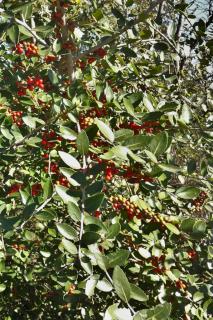

Yaupon holly, also simply called “yaupon“, is a shrub that has been planted in homes along the Gulf of Mexico and the lower Atlantic coast.
Yaupon Holly key facts
Name – Ilex vomitoria
Family – Ilex (holly)
Type – evergreen
Exposure – part sun or full
Soil – either wet or dry
Height – 3 or 4 up to 30 feet
(1 to 10 meters, depends on type)
Yaupon holly is a fabulous berry shrub that will attract birds to your garden. They will thank you with pleasant singsong from October to March!
Yaupon holly is very easy to plant. In spring (or fall as a second choice):
In very heavy soils that are always wet, you might want to ensure drainage with either gravel or clay pebbles along the bottom of the hole, but that’s only in extreme cases when the soil is constantly waterlogged.
For different purposes, it’s best to select the right type of yaupon holly – it will reduce maintenance.
Yaupon holly doesn’t require much care at all, especially when it’s planted in full earth.
Planted in pots, a yaupon holly needs repotting every three years at most (two is best to replenish soil nutrients). Fertilize in the second and third year with normal shrub fertilizer. Avoid fertilizer that contains too much nitrogen, since it might burn the roots.
Growth is slow on yaupon holly, somewhat similar to that of boxwood.
Like boxwood, yaupon holly can be trimmed into lovely topiary forms, especially the dwarf yaupon varieties.
Yaupon holly easily spreads naturally, but you can also propagate your favorite shrub yourself.
It’s always a bet whether the seed you’ll grow will closely resemble the variety that produced it. Indeed, yaupon holly can cross-pollinate among many of its varieties, both dwarf and tall, weeping or straight.
Simply sow in a nursery, then transplant the seedling when it has grown large enough. No need to worry about transplant shock, yaupon holly is very resilient.
Yaupon will send up shoots from roots, wherever they’re uncovered or when the main trunk is very vigorous.
Once a shoot is about a foot tall, you can sever the root with a sharp spade. Transplant the clump either to a pot or to a new location.
If ever you’ve nurtured a yaupon holly from seed, and it turns out to be male, you won’t get any berries from it. You don’t need to pull it out entirely – make the best of the already strong root system and graft it with a female branch!

It’s highly resistant to disease. Only extreme weather will weaken it to the point of letting fungus in. If that is the case, you may have to fend off black spot, powdery mildew, and whitefly insects.
It bounces back in no time even after drastic hat rack pruning.
All in all, you’ll never worry about how to save your yaupon holly. And if you’re growing a dwarf variety, you won’t even need to think about it at all for years on end!
Two types of yaupon holly can easily be found in garden stores, these are either “dwarf yaupon” or regular yaupon.
There are only few diseases that will attack this shrub. Moreover, they will only attack the plant when vulnerable and weakened. For example, overwatering will stress the plant and lead to root rot.
For both of these leaf fungus diseases, the best solution is to avoid wetting leaves when watering. Cutting off infected leaves will keep fungus spores from maturing and spreading.
Yaupon holly doesn’t get infected by any strand of Septoria fungus.
All the varieties of yaupon holly have small, shiny, rich green leaves. Their oval shape and slight round-toothed edge make them a favorite to weave Christmas wreaths. Bright red or yellow berries match the season well, too! Pair arrangements together with regular holly for a great combination.
Yaupon holly tends to grow several trunks at once, like lilac. Select one and cut all others away to help it grow like a tree.
Read also: